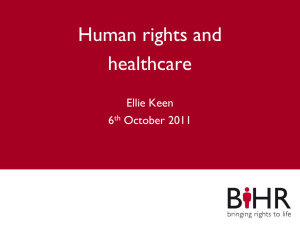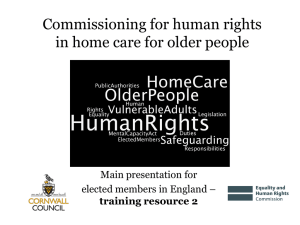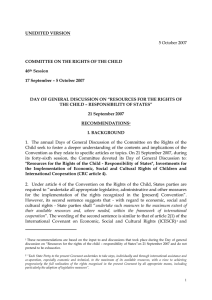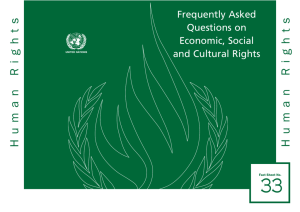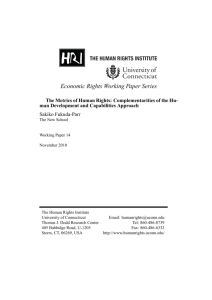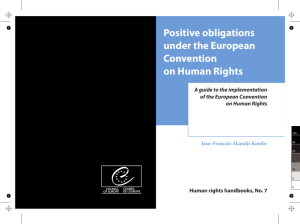DEVELOPMENT WORKING GROUP 3: States parties` obligations
advertisement
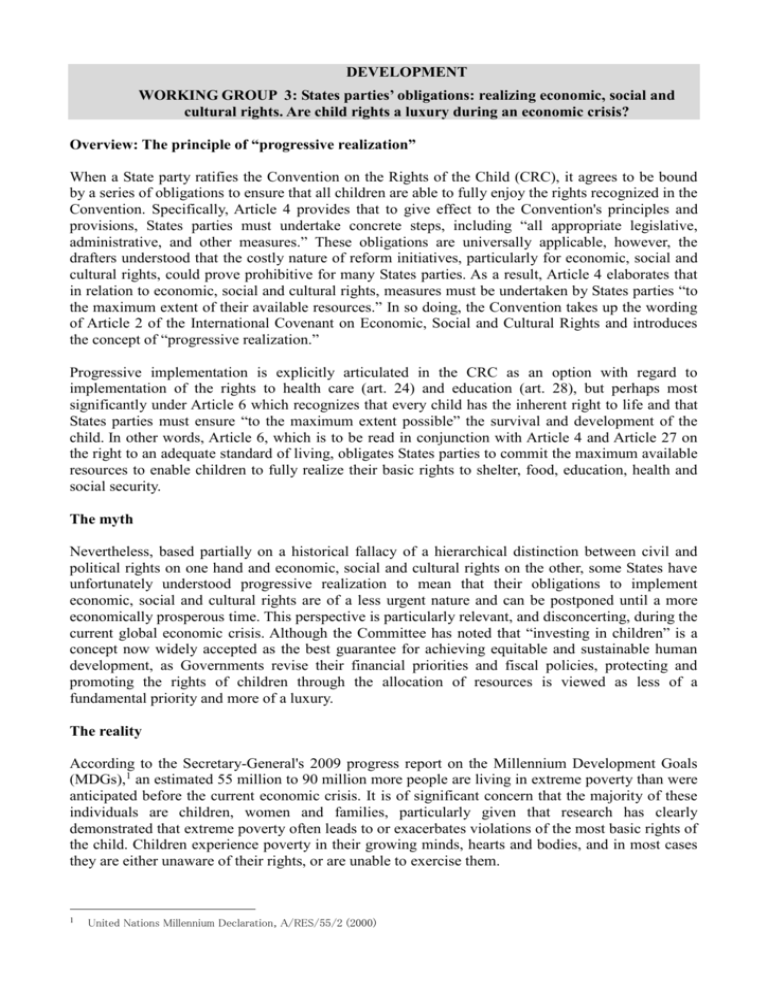
DEVELOPMENT WORKING GROUP 3: States parties’ obligations: realizing economic, social and cultural rights. Are child rights a luxury during an economic crisis? Overview: The principle of “progressive realization” When a State party ratifies the Convention on the Rights of the Child (CRC), it agrees to be bound by a series of obligations to ensure that all children are able to fully enjoy the rights recognized in the Convention. Specifically, Article 4 provides that to give effect to the Convention's principles and provisions, States parties must undertake concrete steps, including “all appropriate legislative, administrative, and other measures.” These obligations are universally applicable, however, the drafters understood that the costly nature of reform initiatives, particularly for economic, social and cultural rights, could prove prohibitive for many States parties. As a result, Article 4 elaborates that in relation to economic, social and cultural rights, measures must be undertaken by States parties “to the maximum extent of their available resources.” In so doing, the Convention takes up the wording of Article 2 of the International Covenant on Economic, Social and Cultural Rights and introduces the concept of “progressive realization.” Progressive implementation is explicitly articulated in the CRC as an option with regard to implementation of the rights to health care (art. 24) and education (art. 28), but perhaps most significantly under Article 6 which recognizes that every child has the inherent right to life and that States parties must ensure “to the maximum extent possible” the survival and development of the child. In other words, Article 6, which is to be read in conjunction with Article 4 and Article 27 on the right to an adequate standard of living, obligates States parties to commit the maximum available resources to enable children to fully realize their basic rights to shelter, food, education, health and social security. The myth Nevertheless, based partially on a historical fallacy of a hierarchical distinction between civil and political rights on one hand and economic, social and cultural rights on the other, some States have unfortunately understood progressive realization to mean that their obligations to implement economic, social and cultural rights are of a less urgent nature and can be postponed until a more economically prosperous time. This perspective is particularly relevant, and disconcerting, during the current global economic crisis. Although the Committee has noted that “investing in children” is a concept now widely accepted as the best guarantee for achieving equitable and sustainable human development, as Governments revise their financial priorities and fiscal policies, protecting and promoting the rights of children through the allocation of resources is viewed as less of a fundamental priority and more of a luxury. The reality According to the Secretary-General's 2009 progress report on the Millennium Development Goals (MDGs),1 an estimated 55 million to 90 million more people are living in extreme poverty than were anticipated before the current economic crisis. It is of significant concern that the majority of these individuals are children, women and families, particularly given that research has clearly demonstrated that extreme poverty often leads to or exacerbates violations of the most basic rights of the child. Children experience poverty in their growing minds, hearts and bodies, and in most cases they are either unaware of their rights, or are unable to exercise them. 1 United Nations Millennium Declaration, A/RES/55/2 (2000) Recognition of the devastating consequences of extreme poverty and its exponential impact on the realization of all other rights, including the right to development, was a central focus of the United Nations Millennium Declaration and a guiding impetus for the establishment of the universal, but flexible indicators and time-bound targeted MDGs. The Secretary-General's 2009 assessment report noted that nine years later, progress in the fight against extreme poverty and hunger, areas in which children often bear the brunt of the burden, has been either inconsistent or has stalled. Further, despite a target to reduce the under-five mortality rate by two-thirds by 2015, nine million children under the age of five died in 2007 (down from 12.7 million in 2005), primarily in developing countries due to largely preventable or treatable causes such as pneumonia, diarrhea, malaria, measles, HIV and malnutrition. Obligations under a rights-based framework In light of the continuing challenges faced by children for their very survival, challenges which are unquestionably magnified during the burgeoning economic crisis, how do we shift the attention back to strategically prioritizing the rights of children and ensure that States parties give effect to their obligations to respect, protect and fulfil the rights recognized by the Convention? One way is to remind States that adopting and implementing a rights-based framework, based on the principles and provisions of the Convention and the other international human rights treaties, can facilitate the effective realization of legislative measures, development plans, national plans of action, and sectorwide poverty reduction strategies, and achievement of the goals and targets of the MDGs. Many States parties argue that although they are committed to protecting and promoting the rights of children, they have insufficient resources to implement these measures. The Committee has always been cognizant of the economic restrictions faced by many States. Nonetheless, through its General Comments, Concluding Observations and at its 2007 Day of General Discussion on “Resources for the Rights of the Child - Responsibility of States: Investments for the Implementation of Economic, Social and Cultural Rights of Children and International Cooperation,” the Committee has continuously rejected financial hardship as a legitimate justification for failures of States parties to “take any, or enough of the required financial or technical measures.” Instead, it has reminded them that while major reforms may be undertaken over time, progressive realization imposes an immediate obligation on all States parties, irrespective of their available resources, to undertake targeted measures as a matter of priority, to satisfy the core minimum content of economic, social and cultural rights, ensuring the minimum conditions under which a person can live in dignity. States parties must consequently demonstrate that they have undertaken all possible efforts to ensure the widest possible enjoyment of the relevant rights, even under “prevailing circumstances”, while paying particular attention to the most disadvantaged and marginalized members or groups of society. As noted by the Secretary-General in the 2009 MDG progress report, the unfavourable economic climate requires the international community to take “the hard decisions needed to create a more equitable and sustainable future.” Finding solutions In suggesting solutions to economic limitations, the Committee has highlighted that Article 4 also provides States parties with the opportunity to seek assistance within the framework of international cooperation; although there are divergent views on whether or not this amounts to a legal obligation. It has stressed that children’s rights are a shared responsibility between developed and developing countries, and that States parties have a duty to provide (rights-based) assistance to other States whenever they are in a position to do so; a view endorsed by the 20/20 Initiative. And, according to the outcome document of the General Assembly's Special Session on Children “A World Fit for Children,” “[p]romoting healthy lives, including good nutrition and control of infectious diseases, providing quality education, protecting children from abuse, exploitation, violence and armed conflict and combating HIV/AIDS are achievable goals and are clearly affordable for the global community.”2 The Committee has provided additional guidance on the substantive meaning of Article 4 to promote broader, more holistic ways to interpret and implement this provision. For instance, with regard to “available resources,” the Committee has emphasized that States parties should look beyond monetary units to any resources that can contribute to the implementation of children's economic, social and cultural rights, including human, technical, organizational, natural and information resources, all of which should be periodically assessed in qualitative and quantitative terms. Parents and families should furthermore be supported as among the most essential available resources. Finally, the Committee is of the view that States parties can more effectively identify and measure available resources through the development of comprehensive, disaggregated child-specific indicators that are tied to time-bound targets. Such measures can assist States parties in improving their policy formulation in relation to the rights of the child, and enhance the monitoring and evaluation of progress or regression in the realization of children's rights. Conclusion Bearing these issues in mind, the central question we will consider in this workshop will be how to strategically identify and prioritize the activities and measures that should be undertaken by States parties to ensure that they are implementing their obligations under the Convention “to the maximum extent of their available resources.” 2 A/RES/S-27/2 (2002)
